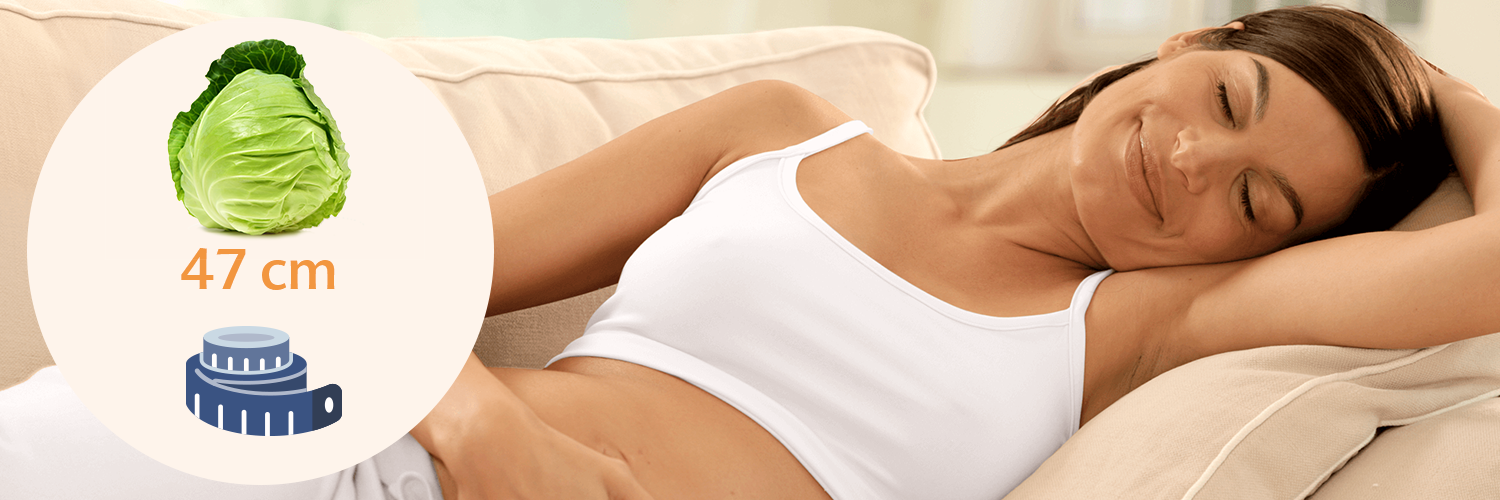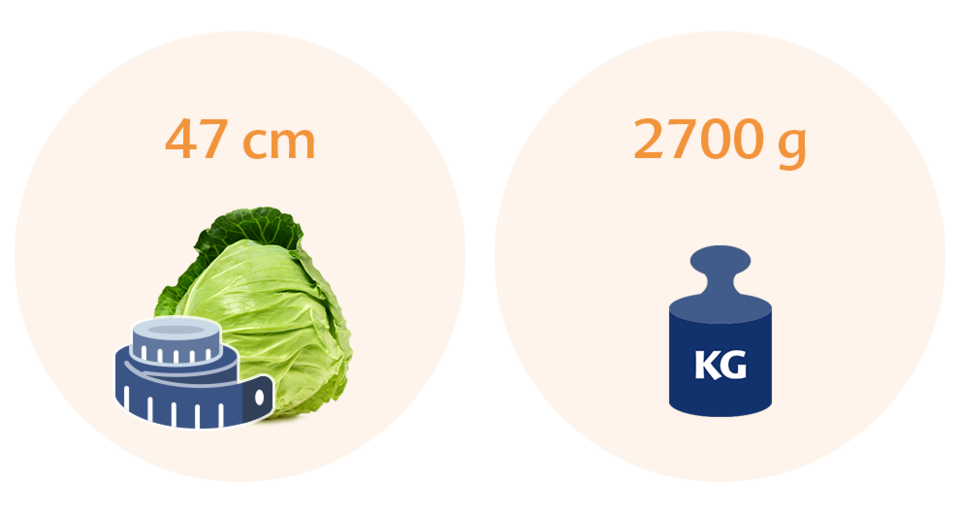Your baby has grown another centimetre in the womb since last week and is now 47 cm long, about the size of a white cabbage. At around 2700 grams, they’re getting close to their birth weight. The main development between now and birth is in their weight, though they’ll grow a bit longer too.
Pregnancy weeks:
Week 36 of pregnancy: Your baby adopts their birth position

Size of your baby in week 36
Your baby’s development
What it’s like for the mum-to-be in week 36
Top tips
Questions you may want to ask your doctor or midwife
Your baby is now fully developed and has all the senses they’ll use from the start of their time outside the womb. If they were born now, they would be considered a “late preterm” baby and there wouldn’t normally be any complications. If they were born at the end of next week (i.e. week 37), they would be considered a “full-term” newborn.
Size of your baby in week 36

Your baby’s development
Over the last few weeks, your baby has built up their fat reserves and “padding”. This will allow them to regulate their body temperature more or less by themselves, although they’ll still need the warmth you can give them in their very first days outside the womb. It’s important to keep your baby warm after they’re born so that they don’t use up too many fat reserves in order to maintain their body temperature – if they did, they’d lose even more weight than they already lose. Babies normally lose between 5 and 10 per cent of their body weight in those first few days, as you’re only producing small amounts of colostrum (though it is rich and full of antibodies) during this time. Your breasts will then engorge and you will produce mature breast milk, which contains the fat they need to put on a healthy amount of weight.
All your baby’s organs, their brain, senses, conduction system and reflexes are working well and as they need to in order for them to survive outside the womb: your child is thus ready for birth and a life as a newborn. They will almost certainly have moved into their birth position by week 36, which involves moving down towards your lesser pelvis. The false labour you’ll experience spasmodically from now on assists this process and moves your baby into the birth canal.
If you’re expecting twins, it’ll be a bit different: the first twin should be in the cephalic position (just as if you were only expecting one baby), and the second twin usually gets into position next to them. In 45 per cent of pregnancies involving twins, both babies are in the normal birth position next to each other. After the first twin passes through the narrow birth canal, the second twin follows – so there’ll be a gap between the birth of the first twin and the birth of the second twin.
In week 36, your baby will be acutely aware of the world outside the womb, hearing different voices and music and noticing when you’re tense or stressed. So it’s important in this final stage of pregnancy to relax as much as you can, focus on you and your baby and build up your strength for the upcoming birth. Your baby is now in a confined space, and it’ll stay that way until they’re born. As they say, there’s no turning back now. Due to the position your baby is in, they won’t move much – this doesn’t mean there’s a problem, they’re simply gathering their strength for what’s about to come.
What it’s like for the mum-to-be in week 36
If you feel it’s necessary, you will now be closely monitored by your doctor and midwife. You’ll have appointments every two weeks rather than every four weeks, and your baby’s heartbeat will be regularly checked. A CTG (if you want one) will record their heartbeat and show whether or not contractions are occurring, while their size, weight and all-round development can be observed via ultrasound or by feeling your belly.
The doctor and midwife will be especially interested in your blood pressure, fluid retention, weight and belly size. In week 36, a vaginal smear for group B streptococcus is also recommended, as this bacteria can give your baby a serious infection when they pass through the birth canal. If you test positive, it needs to be treated properly before you give birth.
Common signs and symptoms
Feeling more pressure
If you’ve already had false labour, you’ll feel more pressure on your pelvis. Your bladder will be feeling the squeeze too, as these kinds of contractions move your baby down towards your lesser pelvis so that it’s in the right position to be born through the birth canal. Back pain may well increase too, and you might notice milky discharge. This comes from the mucus plug in your cervix, but it isn’t yet the sign that the plug has completely disappeared and birth is imminent (as many people think). If the pressure on your pelvis is too much for you to bear, there are exercises that can help relax your pelvic floor and prevent tension.
The benefit of false labour is that you’ll find it easier to breathe, as your lungs are no longer being squeezed by your uterus. This will make you feel freer, encourage you to move around a bit more and help you sleep.
Top tips
- If you feel excessive pressure on your lesser pelvis, moving your hips in a circular motion can help relax your pelvic floor and reduce the pressure.
- Wear natural, non-scented panty liners if you experience discharge or stress incontinence.
- Discuss all your upcoming appointments with your doctor or midwife and make sure you know what to do if you’re unsure about anything.
- Ask your family and friends if they can help you in any way during the first few days and weeks after the birth, particularly if you already have children. This will allow you to focus all your energies on your baby, bond with them and learn how to meet their needs. Of course, you’ll also need plenty of rest after giving birth.
- If you want to have a baby shower, now’s the time to invite your friends over so that they can spoil you and give you your first baby presents.
Questions you may want to ask your doctor or midwife
Taking your blood pressure regularly
Pregnant women have higher blood pressure due to the hormones in their bodies and the need to supply their baby with nutrients. Your heartbeat and heart rate are also higher, so that more blood can be transported around your body.
The Riva-Rocci method, named after its inventor, describes the procedure and equipment for taking blood pressure. Regular checks during pregnancy make sure that your baby is getting the nutrients and all-important oxygen they need from your blood.
Taking your blood pressure allows doctors to see if your body is being overworked or if you have an acute condition, which can often happen from week 36 of pregnancy. If you experience complications like these, it means your baby is not getting what they need and your health can suffer.
Thus it’s important that your doctor or midwife takes your blood pressure (RR) regularly and keeps records of it as a precautionary measure to make sure that no complications resulting from your pregnancy are overlooked.
Information about the author:
Juliane Jacke-Gerlitz is a registered nurse. She has been working in the field of mother and breastfeeding counselling for more than ten years. Currently she is working as a medical writer and psychological consultant. Juliane Jacke-Gerlitz has been married for 22 years, is a mother of eight children and lives with her family in Halle.




